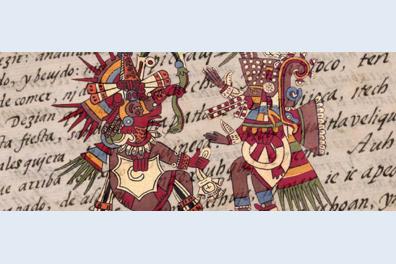This page has been translated automatically.
Nahuatl
Discover the language
The language of the Aztecs
Nahuatl is a language of Mexico that belongs to the Uto-Aztec language family (which also includes the Pima-Tarahumar and Cora-Huichol languages spoken in Mexico, and several North American languages such as Comanche, Hopi and Papago). Nahuatl was the language of the Aztecs between 1325 and the Spanish Conquest (1519-1521), and was the most widely spoken Amerindian language in ancient Mesoamerica. The Aztecs were also familiar with a graphic system of sign-making, a form of writing in pictographs that was used between the 14th and 18th centuries and selectively transcribed the Nahuatl language.
In the aftermath of the Spanish Conquest, indigenous notables and enlightened individuals collected some of the Aztec literature and transcribed it into Latin characters. For their part, missionaries learned Nahuatl in order to evangelize the Indian populations, and produced a large number of texts in the 16th and 17th centuries, many of which bear witness to the daily life of the Aztecs before the conquest. These texts form an abundant corpus that has established what is known today as classical Nahuatl. No other Amerindian language has as rich a corpus of ancient texts as Nahuatl. The study of classical Nahuatl and its texts is therefore of particular interest for our knowledge of Aztec civilization, as is the study of Nahuatl writing as manifested in the pictographic manuscripts traditionally known as "codex".
Modern Nahuatl, in its various dialectal forms, is spoken today by 1,376,000 speakers over the age of five. It can be said to represent Mexico's second language. In addition, a large number of place names as far afield as Guatemala are in Nahuatl, and many Nahuatl words have been assimilated by the Spanish spoken in Mexico, and beyond by our own languages (cite, for example, the words "tomato", "cacao", "avocado", "coyote", etc.).).
Studying Nahuatl at Inalco
Inalco offers all students and auditors 2 hours of weekly classes throughout the academic year. They include an introduction to the Nahuatl language, the study of ancient and modern texts and Aztec pictographic writing. These courses provide an introduction to the language, Nahuatl culture and literature, and the Aztec writing system. They are open to anyone wishing to familiarize themselves with a Native American language and discover Aztec civilization.
Training courses
You have four options for registering for Nahuatl language and/or Nahuatl pictographic writing courses at Inalco:
Registration for DLC Mesoamerica
Opening teaching unit
Registration for minor
Registration for Passeport Langues O'
